These configs were all made with PCem 17+st-1 and libTAS 1.4.2.
Table of contents
Creating the configurations
Late 80s
ROMs
You will need the following ROM files: (THESE ARE CASE-SENSITIVE!)
Filename MD5 ibm_vga.bin 2057a38cb472300205132fb9c01d9d85 109592-005.u11.bin 70e208d5992be21b26fe796d76964c1d 109591-005.u13.bin d35bab5b74fc21fef900b14b0807e126
Put the VGA rom in the folder
~/.pcem/roms/ and the other two in the folder ~/.pcem/roms/deskpro386/.
Config
Make a new config with the following specs. If something is not specified, leave it at default. You may not get some of the options when you make a new config; if this happens, click "OK" to save it and then try editing it again.
- Machine: [386DX] Compaq Deskpro 386
- CPU: Intel i386DX/20
- Memory: 4 MB
- Synchronize time to host clock: Checked
- Device: VGA
- Speed: Default
- Device: Sound Blaster Pro v2 (Address 0x220, IRQ 7, DMA 1, NukedOPL)
- All options unchecked
- LPT Device: None
- HDD: [IDE] Standard IDE
- FDD1: 3.5" 2.88M
- FDD2: 5.25" 1.2M
- CD Model: PCemCD
- CD Speed: 24x
- Drive 0 Primary Master (C:): Hard drive, make a new hard drive of type 09 (Sectors 17, Heads 15, Cylinders 900, 112 MB)
- Mouse: Microsoft 2-button mouse (serial)
NVR
The default NVR file used is
deskpro386.nvr (md5: 367072234f7095aebb4e663fb1dc8f98). It can be found in the folder you installed PCem in under /nvr/default/deskpro386.nvr. To be completely sure your NVR file starts off clean, take this file, copy it to ~/.pcem/nvr/ and name it after your config file (e.g. if your config is named late80s, name it late80s.deskpro386.nvr.) If there is already a file named this, delete it and replace it.
Diagnostic disk
This chipset needs a special diagnostic disk. Without this disk, it's impossible to make important changes to the BIOS like specifying the hard drive type. It uses a common 720K disk that works across many Compaq Portable and Deskpro models, and it has an MD5 hash of
09652bd116a0af7ed006996b001ab9c9. You can find one yourself, or use the following instructions to make one.
You will need
SP0308.EXE (md5: aa6991bbe7449109671508eb27630629) which is inside SP0308.ZIP. This is the SoftPaq Diagnostics 8.00 Rev. B (DP256) utility once distributed by Compaq, which is now owned by Hewlett Packard.
Make another configuration identical to the previous one, except in the Drives tab, set FDD2 to 3.5" 2.88M and eject any hard drives.
You will need three disks for this process.
- Disk 1:
Grab the FreeDOS v1.2 boot floppy from the FreeDOS website in
FD12FLOPPY.zip. The md5 of FLOPPY.img is 36689ac4152d8efb13ab230e9aea46ec.
- Disk 2:
Make a blank 1.44M floppy image and copy
SP0308.EXE onto it. You can do that with the following terminal commands:
mkfs.msdos -C /path/to/sp0308.img 1440
sudo mkdir /media/floppy1/
sudo mount -o loop /path/to/sp0308.img /media/floppy1/
sudo cp -R /path/to/SP0308.EXE /media/floppy1/
sudo umount /media/floppy1/
You will get inconsistent hashes for this image, but it doesn't matter.
- Disk 3:
Make a blank 720K floppy image; this will eventually be your diagnostic disk. You can make this with the following terminal command:
mkfs.msdos -C /path/to/compaqdd.img 720
Again, you will get inconsistent hashes for this. This can be fixed by specifying the volume serial number with the
-i parameter, but it ultimately will not matter.
Launch this new config in PCem. While the system is counting memory, with the right-click menu, change drive A: to your
FLOPPY.img and change drive B: to your sp0308.img. You will get some error after the memory is done counting, press F1 to resume and the computer should boot using the FreeDOS floppy.
FreeDOS setup will start, but we don't need to install it. Select
English as the language and then select No - Return to DOS.
This will take you out to the DOS prompt. Type
B: and press enter to go to the B drive. Use the right click menu to swap drive A to compaqdd.img, the blank 720K disk. B has the setup program on it, so type SP0308 into the prompt and press enter.
The setup program will bring up some legal warnings, press enter, PgDn through the license agreement, then enter "AGREED" into the box at the end.
The setup utility made some new files on the B drive, namely
QRST.EXE. In the DOS prompt, type QRST and press enter.
The new program will ask what type of transfer you want, select
All diskettes in the set (there is only one anyway). It will ask for a blank 720K disk, which you should already have in the A drive, so press enter twice.
Wait for the program to finish writing the disk. When it's done, it will kick you back out to the DOS prompt. Close PCem.
compaqdd.img should now be a working diagnostic disk. Check the hash of it, it should have an MD5 of 09652bd116a0af7ed006996b001ab9c9. If it doesn't match the hash exactly, it may still work fine.
libTAS movie file
At this point, you can run the verification movie if you want our exact hashes:
BIOS
Launch the config (the original one, NOT the one for the diagnostic disk) and wait for the memory test to complete. When prompted, load the diagnostic disk image into drive A: and press F1. You will see a memory test error, this is normal.

On the screen with the Compaq logo, Press Enter to continue setup.
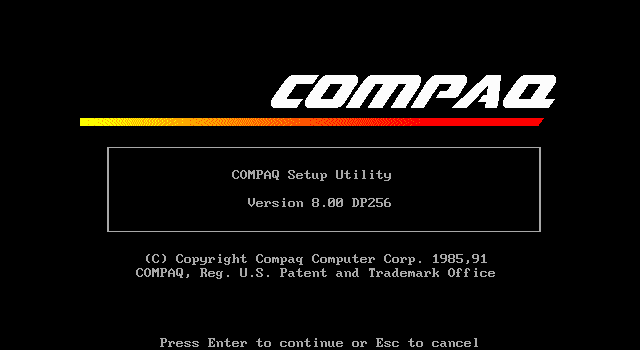
There will be another memory size error screen, press Enter. Put in any valid date and press Enter (libTAS will override this). It will then tell you your configuration was updated, press Enter again.
After reaching the "System Configuration Summary" screen, press F4 to Change Configuration.
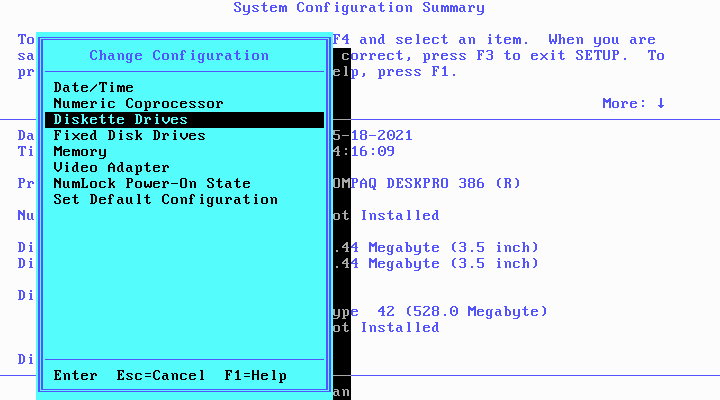
Select the Fixed Disk Drives option and press Enter. Select "Other Type" for Disk Controller 1, Fixed Disk 1 and press Enter.
Type in 09 for the drive type and press Enter.
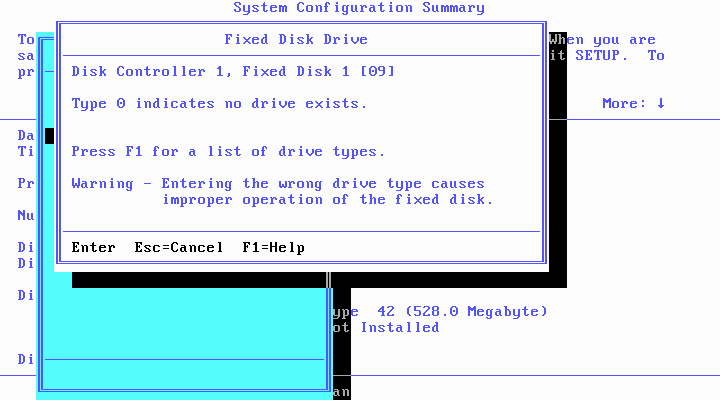
Set Disk Controller 1, Fixed Disk 2 and Disk Controller 2, Fixed Disk 1 to type 0.
Back at the Change Configuration menu, select NumLock Power-On State and press Enter. Change it to On and press Enter.
Press Esc to close the Change Configuration window.
Note that both disk drives are set to 1.44 MB (3.5"). For drive B:, this is not correct, but the 5.25-inch choices cause boot errors, possibly a problem with PCem. Drive B: will be able to read 5.25 inch disks regardless of this choice.
Press F3, then select Exit and save changes.
The PC will restart and look for bootable media. Eject the diagnostic disk from drive A: and proceed to the FreeDOS Installation section.
Early 90s
ROMs
You will need the following ROM files: (THESE ARE CASE-SENSITIVE!)
Filename MD5 1007by0r.bi1 26d8f651e468874e852bdd1ffb6e6804 1007by0r.bio 15d245587d08979f16383190c55fb153 gd5430.bin d4ba691ce5e04d950ca7624050e6b409
Put them in the folder
~/.pcem/roms/pb570/. If there is a file called flash.bin in this folder, delete it.
Config
Make a new config with the following specs. If something is not specified, leave it at default. You may not get some of the options when you make a new config; if this happens, click "OK" to save it and then try editing it again.
- Machine: [Socket 5] Packard Bell PB570
- CPU: Intel Pentium 133
- Memory: 8 MB
- Synchronize time to host clock: Checked
- Device: Built-in video (2 MB memory)
- Speed: Default
- Voodoo graphics: Unchecked
- Device: Sound Blaster 16 (Address 0x220, NukedOPL)
- All options unchecked
- LPT Device: None
- HDD: [IDE] Standard IDE
- FDD1: 3.5" 2.88M
- FDD2: 5.25" 1.2M
- CD Model: PCemCD
- CD Speed: 24x
- Drive 0 Primary Master (C:): Hard drive, make a new hard drive of type 46 (Sectors 17, Heads 15, Cylinders 1224, 152 MB)
- Mouse: 2-button mouse (PS/2)
NVR
The default NVR file used is
pb570.nvr (md5: 9228bf13f3fe46351b1885e073558b67). It can be found in the folder you installed PCem in under /nvr/default/pb570.nvr. To be completely sure your NVR file starts off clean, take this file, copy it to ~/.pcem/nvr/ and name it after your config file (e.g. if your config is named early90s, name it early90s.pb570.nvr.) If there is already a file named this, delete it and replace it.
libTAS movie file
At this point you can run this verification movie in libTAS to get our exact files:
BIOS
Launch the config and wait a while - the system needs to reconfigure itself. Eventually, you will see this screen:
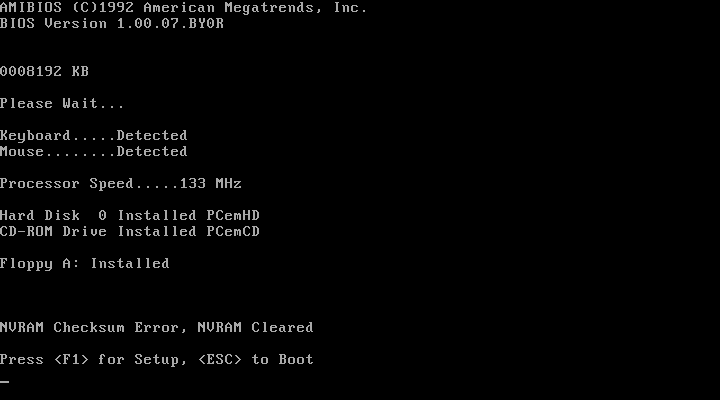
This is normal, it's just a warning that something changed in the system. Press F1 to load setup. Press F5 to load the setup defaults and press enter - this ensures the NVR starts from a clean slate.
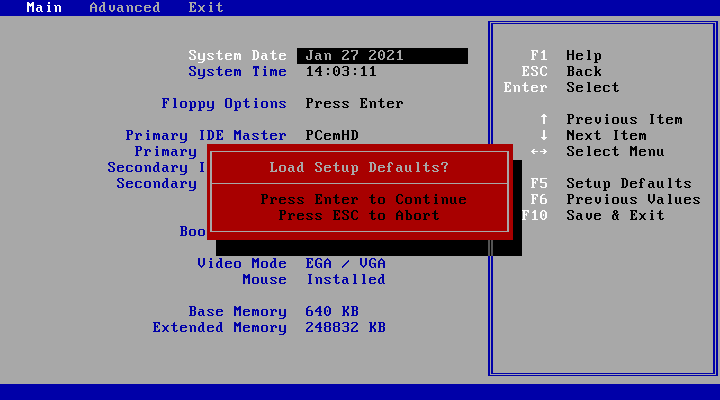
Back on the setup screen, select Floppy Options and press enter.
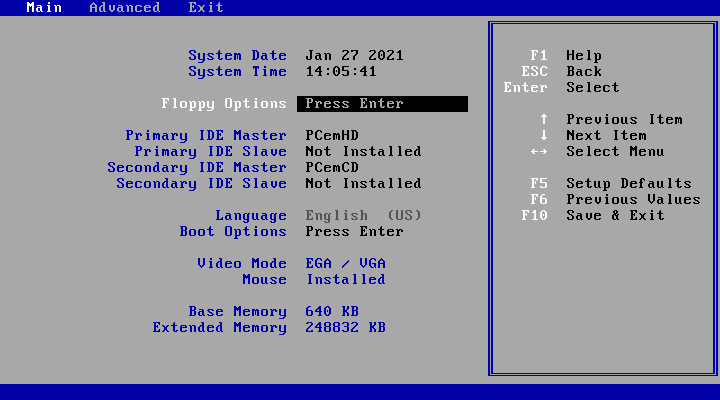
On the Floppy Options screen, set the drives to what they were in the config: A: is a 3.5" 2.88 MB and B: is 5.25" 1.2 MB.
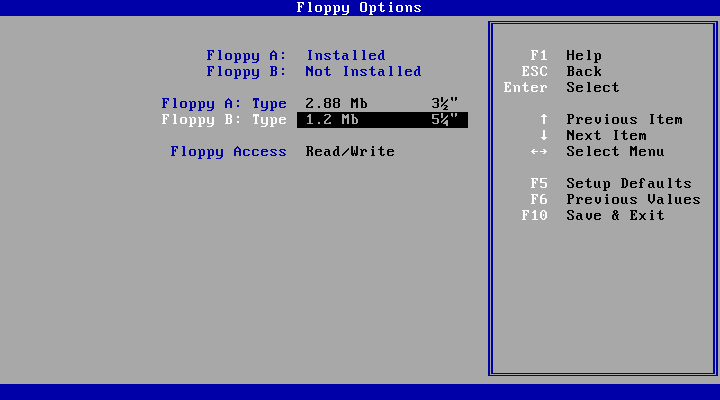
Press Esc to back out to the main setup screen. Now select Boot Options and press enter.

Set the boot order so that the First Boot Device is CD-ROM. Disable the rest for now. Remember how to do this - you will need to change this again later! Press F10 to save and exit.
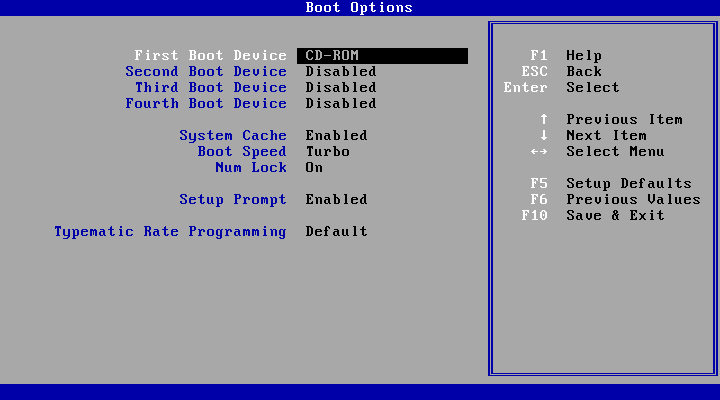
The PC will restart looking for bootable media: proceed to the FreeDOS Installation section.
Late 90s
ROMs
You will need the following ROM files: (THESE ARE CASE-SENSITIVE!)
Filename MD5 6BX.F2a 8ea65e0c1c4934e9a0105bb3fe33a9e9
Put this in the folder
~/.pcem/roms/ga686bx/. If there is a file called flash.bin in this folder, then delete it.
The GPU also needs a ROM file:
Filename MD5 86c764x1.bin fbc57ef320053c50d9034ef493abda4d
Put this in the folder
~/.pcem/roms/.
Config
Make a new config with the following specs. If something is not specified, leave it at default. You may not get some of the options when you make a new config; if this happens, click "OK" to save it and then try editing it again.
- Machine: [Slot 1] Gigabyte GA-686BX
- CPU: Intel Pentium II/450
- Memory: 32 MB
- Synchronize time to host clock: Checked
- Device: Phoenix S3 Trio64 (Click on the button with the tools and set Memory size to 4 MB)
- Speed: Default
- Voodoo Graphics: Checked
- Device: Sound Blaster 16 (Address 0x220, NukedOPL)
- All options unchecked
- LPT Device: None
- HDD: [IDE] Standard IDE
- FDD1: 3.5" 2.88M
- FDD2: 5.25" 1.2M
- CD Model: PCemCD
- CD Speed: 72x
- Drive 0 Primary Master (C:): Hard drive, make a new hard drive with Custom type: Sectors 63, Heads 16, Cylinders 2099 (will result in 1033 MB)
- Drive 1 Primary Slave (D:): CD-ROM
- Mouse: 2-button mouse (PS/2)
NVR
This chipset does not pull the default NVR from a file - just make sure that in
~/.pcem/nvr/ there is no NVR named after your config file (e.g. if your config is named late90s, delete any file called late90s.ga686bx.nvr.)
libTAS movie file
At this point you can run this verification movie to get our exact files:
BIOS
Launch the config and you'll see this (maybe familiar) POST screen:

Hit DEL on this screen before it finishes to enter the setup menu.
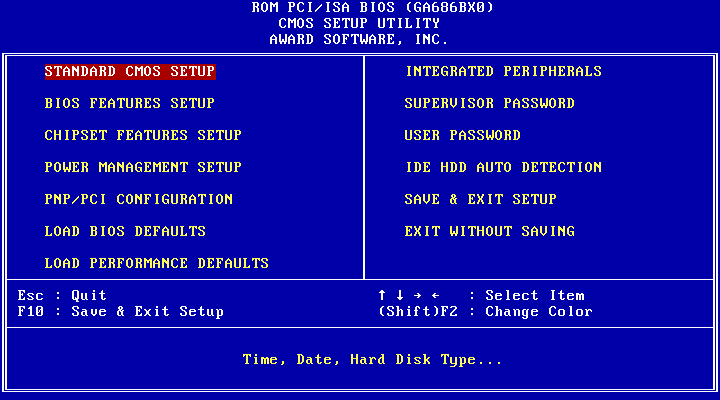
Select Standard CMOS Setup and press Enter. Leave Primary Master and Slave at Auto, and select the Type for Secondary Master and Slave and use PgUp to set them to None. Select Drive A and use PgUp/PgDown to set it to 2.88M, 3.5 in., and then select Drive B and set it to 1.2M, 5.25 in.
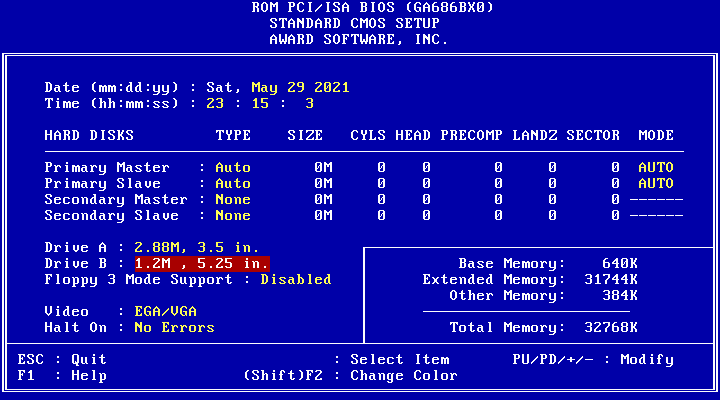
Press Esc to back out to the setup menu. Select BIOS Features Setup and press Enter. Go down to Boot Sequence and use PgUp to set it to CDROM, A, C. Remember how to do this - you will have to change it to boot to C later.
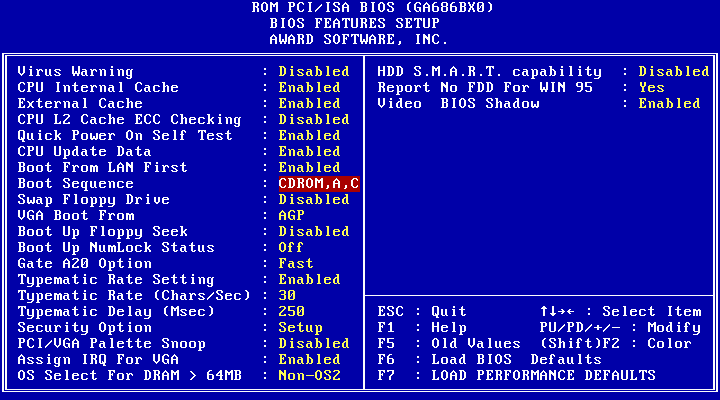
Press Esc to back out to the setup menu and then press F10 to save & exit setup. Press Y and then Enter to save to CMOS and exit. The PC will restart looking for bootable media: proceed to the FreeDOS Installation section.
FreeDOS installation
Media
These configs will have FreeDOS 1.2 installed on them. For these configs, you will need the Legacy installer. You can get everything on the FreeDOS website.
Right-click on the PCem window and use CD-ROM -> Load image to load FD12LGCY.iso (
md5: a55750577b4c3b88dba489df4f929f88). If your system is older and doesn't support booting from CD (like the 80s setups), you'll also need to download FD12FLOPPY.zip (md5: 6c3077be89db961a883b1587385aa65e) and mount FLOPPY.img using Disc -> Change drive A. Restart the system when everything is mounted.
Installation
You will get some messages about illegal partitions - this is normal, the drive hasn't been formatted yet. Partitioning and formatting is built in to the FreeDOS installer to make this as easy as possible. On the first couple screens, choose English and choose Yes to continue with the installation. You will get a message saying drive C: is not partitioned yet, choose Yes to continue. Once the partitioning is complete, reboot the system with System -> Hard Reset (PCem doesn't like the installer's restarts for some reason).
Once the CD boots up again (you may have to mount it again), pick English again and Yes to continue the installation. The installer will ask you if you want to format, choose Yes. The drive will be formatted and you should see a screen like this:
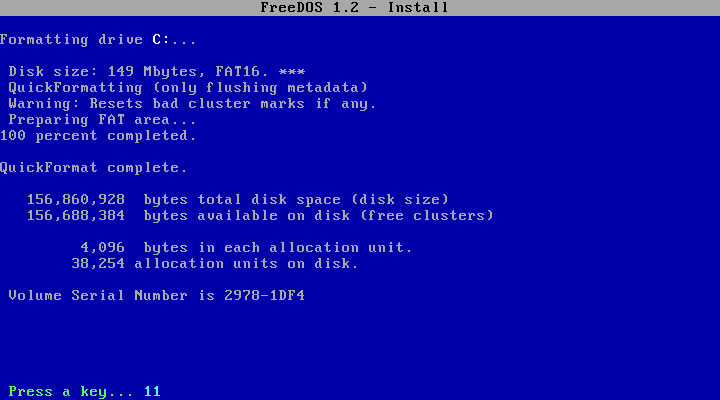
Once it finishes loading, pick US English as the keyboard layout. When it asks what FreeDOS packages to install, pick Base packages only.
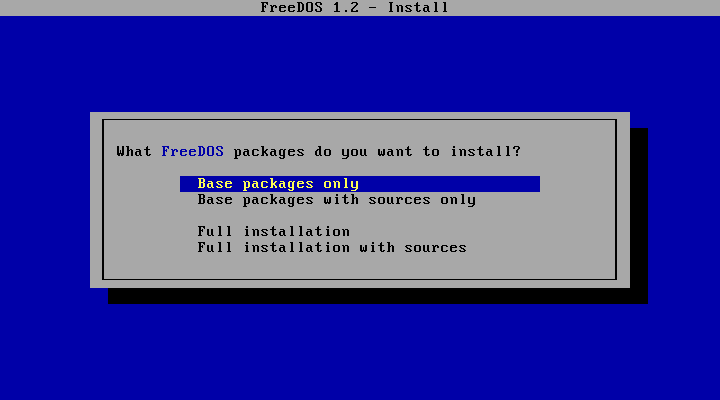
Choose Yes on the next screen to install. Installation will take a few minutes. When it's done, reboot with System -> Hard reset again.
Boot order
The hard drive is now bootable, so you should change the boot order so that it's the first option. When the system restarts, enter the BIOS again. How you do this will depend on the chipset you're using.
Late 80s
The boot order can't be changed, just eject the floppy disk.
Early 90s
Hit F1 at POST and go to Boot Options. Put the list in the following order: Hard Disk, CD-ROM, Floppy, Disabled. Press F10 to save and exit.
Late 90s
Hit DEL at POST and go to BIOS Features Setup. Set Boot Sequence to C, CDROM, A. Press Esc, then F10, then Y, then Enter.
Set blaster
The last thing to do is set the proper Sound Blaster variables. To do this, you will have to edit AUTOEXEC.BAT.
When you boot the config, it will now take you to a
C:> prompt. Type edit AUTOEXEC.BAT into the prompt and hit enter. You should see this:
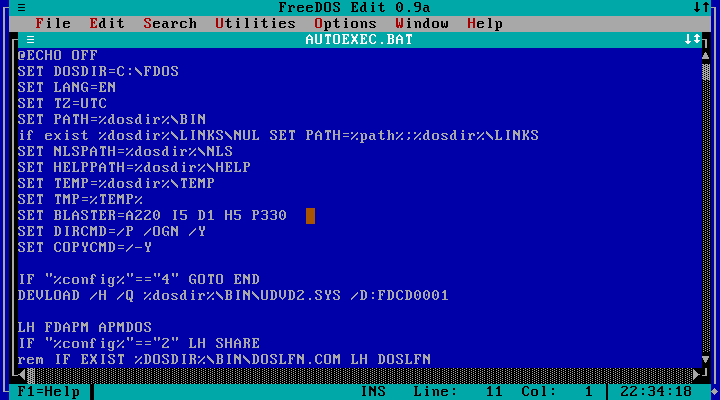
Note the line that starts with
SET BLASTER - this is the one you will be changing. What you change it to depends on the type of Sound Blaster you picked - look here for more info. The IRQ is always 7, the DMA is always 1, the high DMA is always 5, and the I/O port was set in the Sound tab when the config was made. For the premade configs, replace this line with one of the following:
Late 80s
SET BLASTER=A220 I7 D1 T4
Early 90s and Late 90s
SET BLASTER=A220 I7 D1 H5 P330 T6
Once this line is changed, in the editor pick File -> Save and then File -> Exit. The config should now be ready to use!
Note that you will not have the same file hashes as the ones we provide unless you run the verification movie. The times and dates stored in the files will be different.
Custom installation
If you need to format the hard drive yourself and install something else, put in your boot disk and restart PCem.
After you boot PCem with the boot disk in the floppy drive, eventually you'll be met with an
A:> prompt.

Any good boot disk will have FDISK and FORMAT on it.
Partitioning
- Type
fdiskinto the prompt and hit Enter. - Say yes to large disk support.
- Choose option 1 on the next menu to create a DOS partition
- Pick option 1 again to make a primary DOS partition.
- Say yes to using the maximum available space and making it the active partition.
If all goes well, you should see a screen like this:
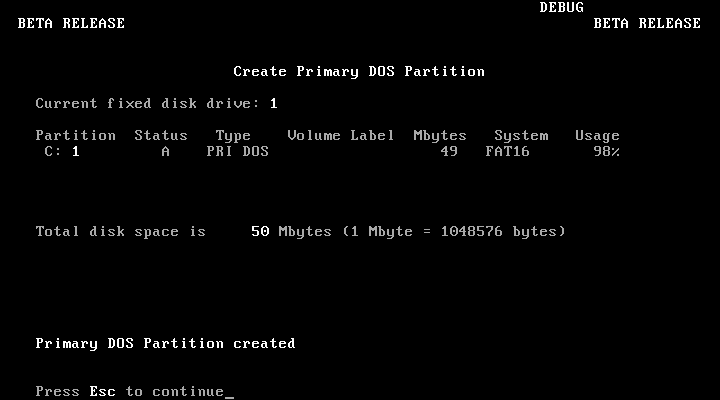
The drive is now partitioned. Escape out of FDISK and restart PCem like it wants you to.
Formatting
Now it's time to format.
- Let the system boot up again and get to the
A:>prompt. - Type
format c:
and press Enter. - You'll get a warning that all data will be lost, but there is no data anyway, so say yes.
- Give the volume a name (or leave it blank) and hit Enter.
You should see a screen like this once it's finished:
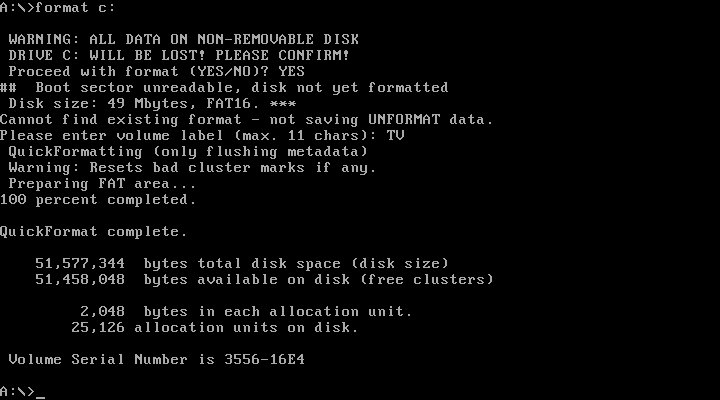
The hard drive is now ready to be used. After you install your game and get libTAS set up, you should be ready to start TASing at this point.
Note
You can press F8 after the POST screen to step through each line in
fdconfig.sys and autoexec.bat. Only do this if you know what you're doing, but you can use this to skip loading things like emm386, ctmouse, and/or the CD drivers.